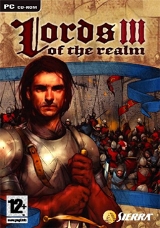
Lords of the Realm III
Encyclopedia
Lords of the Realm III is a real-time strategy
computer game published on March 17, 2004 by Sierra Entertainment
. It is the latest game in the Lords of the Realm
series, and the last game made by Impressions Games
. While the game did receive mainly good reviews, many gamers criticized the game for being completely different from the first two games.
Once a noble is selected, the player can choose to play a campaign or battle map, or load a saved game. While all the battle maps are available when a noble is created, the campaigns require that the player complete each level in sequence.
Campaign 1 - Ireland
Campaign 2 - England
Campaign 3 - Germany
Campaign 4 - France
There are several different types of parcels that dictate what they will produce. Furthermore, each parcel is of a certain quality which determines how fast they will upgrade their land and produce units. The different categories of vassals are as follows:
Real-time strategy
Real-time strategy is a sub-genre of strategy video game which does not progress incrementally in turns. Brett Sperry is credited with coining the term to market Dune II....
computer game published on March 17, 2004 by Sierra Entertainment
Sierra Entertainment
Sierra Entertainment Inc. was an American video-game developer and publisher founded in 1979 as On-Line Systems by Ken and Roberta Williams...
. It is the latest game in the Lords of the Realm
Lords of the Realm
Lords of the Realm is a turn-based strategy computer game published and developed by Impressions Games. It was first released on June 15, 1994, and is the first game in the Lords of the Realm series....
series, and the last game made by Impressions Games
Impressions Games
Impressions Games was a video game developer founded by David Lester in the UK. He sold the company to Sierra Entertainment in 1995, who was then bought out by Cendant and eventually, Vivendi Universal ....
. While the game did receive mainly good reviews, many gamers criticized the game for being completely different from the first two games.
Gameplay
At the start of a game, the player must choose a noble by either selecting one of the default nobles or creating a new one. Nobles act as user accounts within the game, wherein completed campaigns and saved games are local to each noble. A noble consists of three customizable features: housename, portrait, and heraldry.Once a noble is selected, the player can choose to play a campaign or battle map, or load a saved game. While all the battle maps are available when a noble is created, the campaigns require that the player complete each level in sequence.
Campaigns
The game has four campaigns, each with several scenarios:Campaign 1 - Ireland
- Scenario 1 - High King of Ireland
Campaign 2 - England
- Scenario 1 - William the Conqueror
- Scenario 2 - Simon de Montfort
- Scenario 3 - King Edward's war
- Scenario 4 - The Black Prince
- Scenario 5 - Albion forever
Campaign 3 - Germany
- Scenario 1 - Barbarossa in Italy
- Scenario 2 - A gathering of wolves
- Scenario 3 - Henry the Lion
- Scenario 4 - The Golden Bull
Campaign 4 - France
- Scenario 1 - Albigensian Crusade
- Scenario 2 - Angevin Empire
- Scenario 3 - Maid of Orleans
- Scenario 4 - Vive le roi
Battle maps
In a battle map, the player is placed in a battlefield and is provided with predefined companies of soldiers available to them. The only victory condition of these battles is to defeat all enemy companies. The gameplay is consistent with that of the battle mode in the campaigns.Layers
Except for the tutorials, campaigns consist of three layers of gameplay: the strategy layer, the diplomacy layer, and the battle layer. The layers allow the player to control different components of the game.Strategy layer and vassalage
The strategy layer allows the player to see a large overview of the lands to command their armies and assign vassals to the lands they possess. The land that the player possesses is subdivided into parcels. The player must assign a vassal to each parcel to manage the land for them.There are several different types of parcels that dictate what they will produce. Furthermore, each parcel is of a certain quality which determines how fast they will upgrade their land and produce units. The different categories of vassals are as follows:
- Knight - Builds a fort on a parcel, which will produce a company of a certain type that is based on the knight.
- Priest - A priest will build a church on a parcel which increase the player's Christianity level.
- Burgher - A burgher builds a city on their designated parcel that produces gold to be spent on upgrades to the player's castle or hiring mercenaries.
- Serf - Serfs build farmlands on parcels that supply the armies with food.

